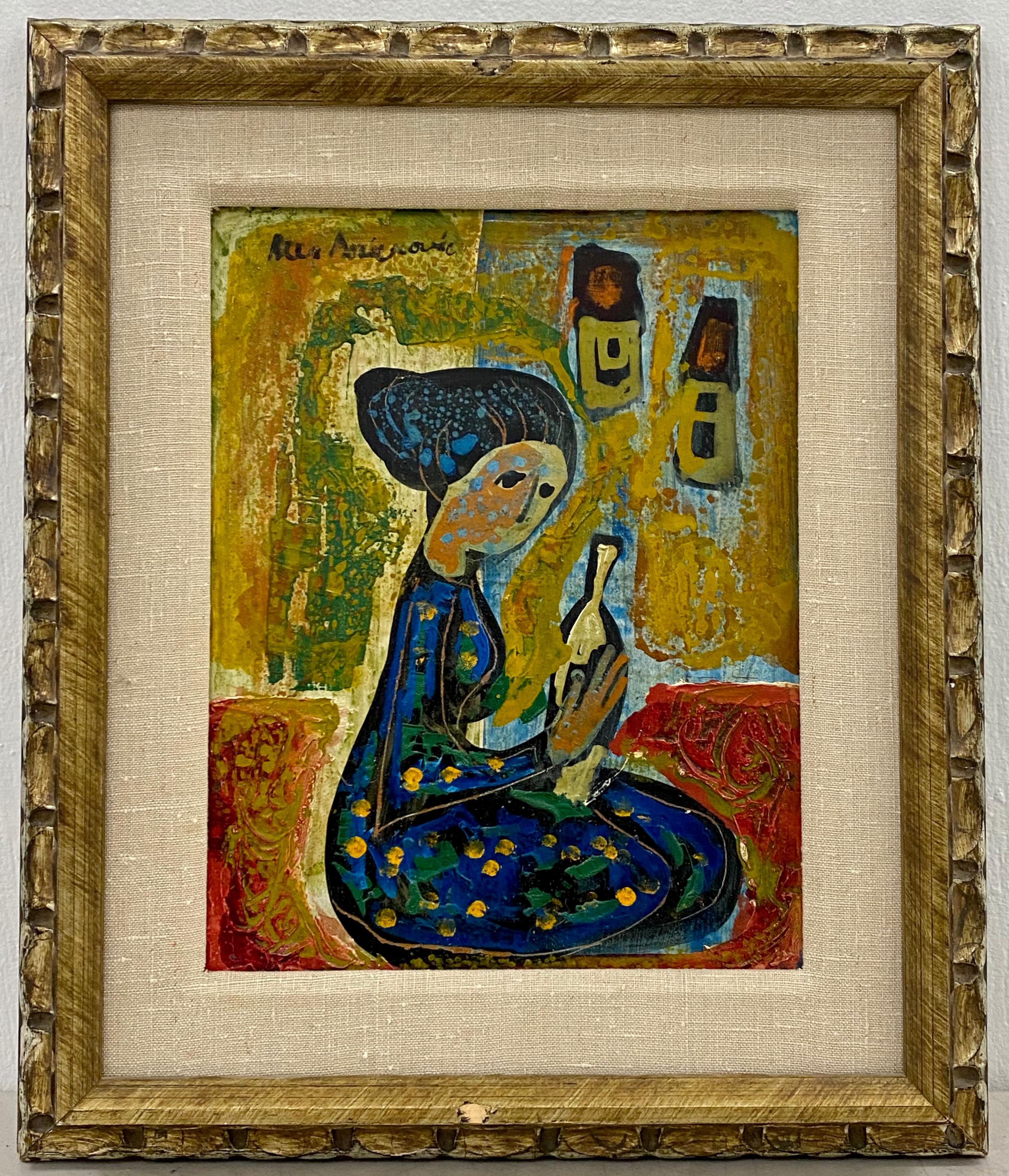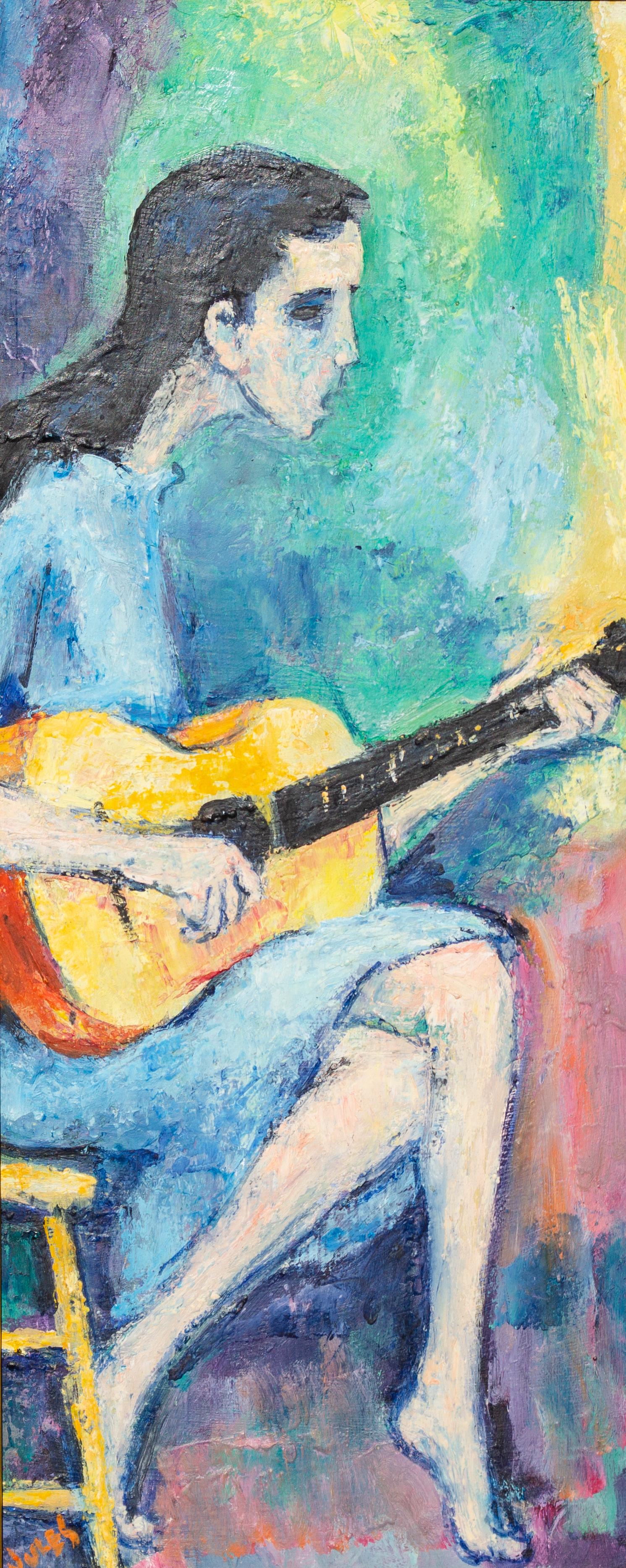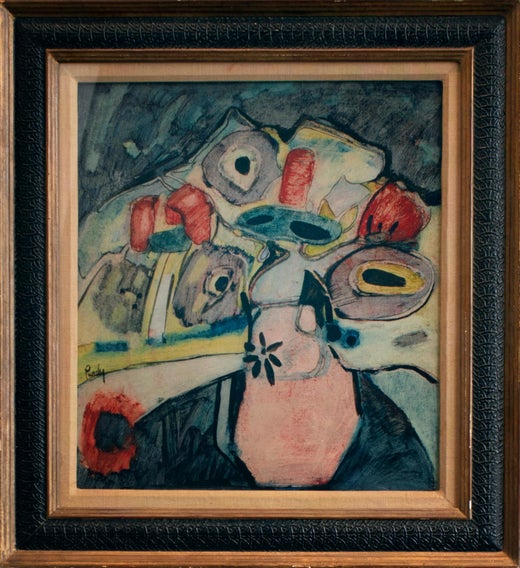Items Similar to Rabbi with Torah, 1970s Oil Painting by Donald Roy Purdy
Want more images or videos?
Request additional images or videos from the seller
1 of 7
Donald Roy PurdyRabbi with Torah, 1970s Oil Painting by Donald Roy Purdycirca 1970
circa 1970
About the Item
Artist: Donald Roy Purdy, American (1924 - )
Title: Rabbi with Torah
Year: circa 1970
Medium: Oil on Masonite, signed l.r.
Size: 36 x 24 in. (91.44 x 60.96 cm)
Frame Size: 45 x 31 inches
- Creator:Donald Roy Purdy (1924, American)
- Creation Year:circa 1970
- Dimensions:Height: 45 in (114.3 cm)Width: 31 in (78.74 cm)
- Medium:
- Movement & Style:
- Period:
- Condition:Minor wear consistent with age and history.
- Gallery Location:Long Island City, NY
- Reference Number:1stDibs: LU4663192071
Donald Roy Purdy
Self-taught, Purdy was influenced by many artists, including the Barbizon School, French Impressionists and Post-Impressionists, and American 19th Century Painters. No particular artistic influence was evident during his childhood. After high school, he enlisted in the army air force and entered Germany as a foot soldier with the 9th army. After the war, Purdy pursued a degree in Psychology, graduating in 1949 from the University of Connecticut and from Boston University with his Master’s in Psychology in 1950. While in Boston, Purdy worked in an art gallery, performing tasks such as framing pictures. It was here that he first became art-conscious and was surprised to learn that individuals actually chose art as a profession. Purdy lived and painted most of his life in New England. He exhibited extensively throughout the U.S. and Europe, including: The Britain Museum, Connecticut; The Butler Institute, Columbus, Ohio; Colby College, Maine; The University of Kansas; The Chrysler Collection; and Bernheim-Jeune Galleries, Paris. In addition, he has been honored with numerous awards including a Gold Medal from the Allied Artists. He was a teacher of painting at the Silvermine Academy of Art in Connecticut and is listed in Who’s Who in American Art.
About the Seller
4.8
Platinum Seller
These expertly vetted sellers are 1stDibs' most experienced sellers and are rated highest by our customers.
Established in 1979
1stDibs seller since 2014
2,697 sales on 1stDibs
Typical response time: <1 hour
- ShippingRetrieving quote...Ships From: Long Island City, NY
- Return PolicyA return for this item may be initiated within 7 days of delivery.
More From This SellerView All
- Rabbi holding the Torah, Oil Painting by Donald Roy PurdyBy Donald Roy PurdyLocated in Long Island City, NYArtist: Donald Roy Purdy, American (1924 - ) Title: Rabbi 3 Year: circa 1970 Medium: Oil on Masonite, signed l.r. Size: 30 x 24 in. (76.2 x 60.96 cm) Frame Size: 38 x 31 inchesCategory
1970s Modern Figurative Paintings
MaterialsOil, Masonite
- Rabbi 3, 1970s Oil Painting by Donald Roy PurdyBy Donald Roy PurdyLocated in Long Island City, NYArtist: Donald Roy Purdy, American (1924 - ) Title: Rabbi 3 Year: circa 1970 Medium: Oil on Masonite, signed l.r. Size: 24 x 30 in. (60.96 x 76.2 cm) Frame Size: 34 x 39 inchesCategory
1970s Modern Figurative Paintings
MaterialsOil, Masonite
- Rabbi, 1970s Oil Painting by Donald Roy PurdyBy Donald Roy PurdyLocated in Long Island City, NYArtist: Donald Roy Purdy, American (1924 - ) Title: Rabbi with Torah Year: circa 1970 Medium: Oil on Masonite, signed l.r. Size: 30 x 22.5 in. (76.2 x 57.15 cm) Frame Size: 38 x 31 i...Category
1970s Modern Figurative Paintings
MaterialsOil, Masonite
- Conductor with Orchestra, Figurative Oil Painting by William HarndenBy William HarndenLocated in Long Island City, NYArtist: William Harnden, American (1920 - 1983) Title: Conductor with Orchestra Medium: Oil on Masonite, signed Image Size: 15.5 x 19 inches Frame Size: 18 x 21 inchesCategory
1950s American Modern Figurative Paintings
MaterialsOil, Masonite
- Concert, Figurative Oil Painting by William HarndenBy William HarndenLocated in Long Island City, NYArtist: William Harnden, American (1920 - 1983) Title: Concert Medium: Oil on Masonite, signed Image Size: 15.5 x 20 inches Frame Size: 22.5 x 27 inchesCategory
1950s American Modern Figurative Paintings
MaterialsOil, Masonite
- Conductor and Singer, Figurative Oil Painting by William HarndenBy William HarndenLocated in Long Island City, NYArtist: William Harnden, American (1920 - 1983) Title: Conductor with Singer Medium: Oil on Masonite, signed Image Size: 11.5 x 23.5 inches Frame Size: 17.5 x 30 inchesCategory
1950s American Modern Figurative Paintings
MaterialsOil, Masonite
You May Also Like
- Alex Bozickovic "Girl With Bottle" Original Oil Painting C.1960sLocated in San Francisco, CAAlex Bozickovic (Alex Boz) (Bosnian Yugoslavian, 1919-1982) "Girl With Bottle" Original Oil Painting C.1960s Fine oil painting on masonite of a young woman with a polka dot dress ho...Category
Mid-20th Century Modern Figurative Paintings
MaterialsMasonite, Oil
- Mervin Jules Folk Singer Portrait, SignedBy Mervin JulesLocated in Larchmont, NYMervin Jules (American, 1912-1994) Folk Singer, 20th century Oil on masonite 18 x 7 1/2 in. Signed lower left: Jules Provenance: Garelick's Gallery, Detroit Matte included, no fram...Category
20th Century American Modern Figurative Paintings
MaterialsMasonite, Oil
- Inevitable Day – Birth of the Atom oil and tempera painting by Julio De DiegoBy Julio de DiegoLocated in Hudson, NYJulio De Diego’s Atomic Series paintings made an extraordinary statement regarding the shock and fear that accompanied the dawn of the nuclear age. In the artist’s own words, “Scientists were working secretly to develop formidable powers taken from the mysterious depths of the earth - with the power to make the earth useless! Then, the EXPLOSION! . . . we entered the Atomic Age, and from there the neo-Atomic war begins. Explosions fell everywhere and man kept on fighting, discovering he could fight without flesh.” To execute these works, De Diego developed a technique of using tempera underpainting before applying layer upon layer of pigmented oil glazes. The result is paintings with surfaces which were described as “bonelike” in quality. The forms seem to float freely, creating a three-dimensional visual effect. In the 1954 book The Modern Renaissance in American Art, author Ralph Pearson summarizes the series as “a fantastic interpretation of a weighty theme. Perhaps it is well to let fantasy and irony appear to lighten the devastating impact. By inverse action, they may in fact increase its weight.” Bibliography Art in America, April 1951, p.78 About this artists: Julio De Diego crafted a formidable persona within the artistic developments and political struggles of his time. The artist characterized his own work as “lyrical,” explaining, “through the years, the surrealists, the social-conscious painters and the others tried to adopt me, but I went my own way, good, bad or indifferent.” [1] His independence manifested early in life when de Diego left his parent’s home in Madrid, Spain, in adolescence following his father’s attempts to curtail his artistic aspirations. At the age of fifteen he held his first exhibition, set up within a gambling casino. He managed to acquire an apprenticeship in a studio producing scenery for Madrid’s operas, but moved from behind the curtains to the stage, trying his hand at acting and performing as an extra in the Ballet Russes’ Petrouchka with Nijinsky. He spent several years in the Spanish army, including a six-month stretch in the Rif War of 1920 in Northern Africa. His artistic career pushed ahead as he set off for Paris and became familiar with modernism’s forays into abstraction, surrealism, and cubism. The artist arrived in the U.S. in 1924 and settled in Chicago two years later. He established himself with a commission for the decoration of two chapels in St. Gregory’s Church. He also worked in fashion illustration, designed magazine covers and developed a popular laundry bag for the Hotel Sherman. De Diego began exhibiting through the Art Institute of Chicago in 1929, and participated in the annual Chicago Artists Exhibitions, Annual American Exhibitions, and International Water Color Exhibitions. He held a solo exhibition at the Art Institute of Chicago in the summer of 1935. Though the artist’s career was advancing, his family life had deteriorated. In 1932 his first marriage dissolved, and the couple’s young daughter Kiriki was sent to live with friend Paul Hoffman. De Diego continued to develop his artistic vocabulary with a growing interest in Mexican art. He traveled throughout the country acquainting himself with the works of muralists such as Carlos Merida, and also began a collection of small native artifacts...Category
1940s American Modern Abstract Paintings
MaterialsMasonite, Oil, Tempera
- St. Atomic oil and tempera painting by Julio de DiegoBy Julio de DiegoLocated in Hudson, NYJulio De Diego’s Atomic Series paintings made an extraordinary statement regarding the shock and fear that accompanied the dawn of the nuclear age. In the artist’s own words, “Scientists were working secretly to develop formidable powers taken from the mysterious depths of the earth - with the power to make the earth useless! Then, the EXPLOSION! . . . we entered the Atomic Age, and from there the neo-Atomic war begins. Explosions fell everywhere and man kept on fighting, discovering he could fight without flesh.” To execute these works, De Diego developed a technique of using tempera underpainting before applying layer upon layer of pigmented oil glazes. The result is paintings with surfaces which were described as “bonelike” in quality. The forms seem to float freely, creating a three-dimensional visual effect. In the 1954 book The Modern Renaissance in American Art, author Ralph Pearson summarizes the series as “a fantastic interpretation of a weighty theme. Perhaps it is well to let fantasy and irony appear to lighten the devastating impact. By inverse action, they may in fact increase its weight.” Exhibited 1950 University of Illinois at Urbana "Contemporary American Painting" 1964 Marion Koogler McNay Art Institute, San Antonio, Texas This work retains its original frame which measures 54" x 36" x 2". About this artist: Julio De Diego crafted a formidable persona within the artistic developments and political struggles of his time. The artist characterized his own work as “lyrical,” explaining, “through the years, the surrealists, the social-conscious painters and the others tried to adopt me, but I went my own way, good, bad or indifferent.” [1] His independence manifested early in life when de Diego left his parent’s home in Madrid, Spain, in adolescence following his father’s attempts to curtail his artistic aspirations. At the age of fifteen he held his first exhibition, set up within a gambling casino. He managed to acquire an apprenticeship in a studio producing scenery for Madrid’s operas, but moved from behind the curtains to the stage, trying his hand at acting and performing as an extra in the Ballet Russes’ Petrouchka with Nijinsky. He spent several years in the Spanish army, including a six-month stretch in the Rif War of 1920 in Northern Africa. His artistic career pushed ahead as he set off for Paris and became familiar with modernism’s forays into abstraction, surrealism, and cubism. The artist arrived in the U.S. in 1924 and settled in Chicago two years later. He established himself with a commission for the decoration of two chapels in St. Gregory’s Church. He also worked in fashion illustration, designed magazine covers and developed a popular laundry bag for the Hotel Sherman. De Diego began exhibiting through the Art Institute of Chicago in 1929, and participated in the annual Chicago Artists Exhibitions, Annual American Exhibitions, and International Water Color Exhibitions. He held a solo exhibition at the Art Institute of Chicago in the summer of 1935. Though the artist’s career was advancing, his family life had deteriorated. In 1932 his first marriage dissolved, and the couple’s young daughter Kiriki was sent to live with friend Paul Hoffman. De Diego continued to develop his artistic vocabulary with a growing interest in Mexican art. He traveled throughout the country acquainting himself with the works of muralists such as Carlos Merida, and also began a collection of small native artifacts...Category
1940s American Modern Abstract Paintings
MaterialsMasonite, Oil, Tempera
- The Magician oil and tempera painting by Julio de DiegoBy Julio de DiegoLocated in Hudson, NYJulio De Diego’s Atomic Series paintings made an extraordinary statement regarding the shock and fear that accompanied the dawn of the nuclear age. In the artist’s own words, “Scientists were working secretly to develop formidable powers taken from the mysterious depths of the earth - with the power to make the earth useless! Then, the EXPLOSION! . . . we entered the Atomic Age, and from there the neo-Atomic war begins. Explosions fell everywhere and man kept on fighting, discovering he could fight without flesh.” To execute these works, De Diego developed a technique of using tempera underpainting before applying layer upon layer of pigmented oil glazes. The result is paintings with surfaces which were described as “bonelike” in quality. The forms seem to float freely, creating a three-dimensional visual effect. In the 1954 book The Modern Renaissance in American Art, author Ralph Pearson summarizes the series as “a fantastic interpretation of a weighty theme. Perhaps it is well to let fantasy and irony appear to lighten the devastating impact. By inverse action, they may in fact increase its weight.” Exhibited 1964 Marion Koogler McNay Art Institute, San Antonio, Texas This work retains its original frame which measures 54" x 42" x 2" About this artist: Julio De Diego crafted a formidable persona within the artistic developments and political struggles of his time. The artist characterized his own work as “lyrical,” explaining, “through the years, the surrealists, the social-conscious painters and the others tried to adopt me, but I went my own way, good, bad or indifferent.” [1] His independence manifested early in life when de Diego left his parent’s home in Madrid, Spain, in adolescence following his father’s attempts to curtail his artistic aspirations. At the age of fifteen he held his first exhibition, set up within a gambling casino. He managed to acquire an apprenticeship in a studio producing scenery for Madrid’s operas, but moved from behind the curtains to the stage, trying his hand at acting and performing as an extra in the Ballet Russes’ Petrouchka with Nijinsky. He spent several years in the Spanish army, including a six-month stretch in the Rif War of 1920 in Northern Africa. His artistic career pushed ahead as he set off for Paris and became familiar with modernism’s forays into abstraction, surrealism, and cubism. The artist arrived in the U.S. in 1924 and settled in Chicago two years later. He established himself with a commission for the decoration of two chapels in St. Gregory’s Church. He also worked in fashion illustration, designed magazine covers and developed a popular laundry bag for the Hotel Sherman. De Diego began exhibiting through the Art Institute of Chicago in 1929, and participated in the annual Chicago Artists Exhibitions, Annual American Exhibitions, and International Water Color Exhibitions. He held a solo exhibition at the Art Institute of Chicago in the summer of 1935. Though the artist’s career was advancing, his family life had deteriorated. In 1932 his first marriage dissolved, and the couple’s young daughter Kiriki was sent to live with friend Paul Hoffman. De Diego continued to develop his artistic vocabulary with a growing interest in Mexican art. He traveled throughout the country acquainting himself with the works of muralists such as Carlos Merida, and also began a collection of small native artifacts...Category
1940s American Modern Abstract Paintings
MaterialsMasonite, Oil, Tempera
- “Jest a Hornblower”By Roy M. SteinbergLocated in Southampton, NYVery beautiful oil on masonite painting by the American mid century modern artist Roy M. Steinberg. Signed lower left. Circa 1955. Condition is very good; no issues. A jester blowi...Category
1950s Modern Figurative Paintings
MaterialsMasonite, Oil
Recently Viewed
View AllRead More
Chryssa’s 1962 Neon Sculpture Was Way ahead of the Art-World Curve
By working with lettering, neon and Pop imagery, Chryssa pioneered several postmodern themes at a time when most male artists detested commercial mediums.
7 Exciting Works by Female Artists from the RoGallery Auction
Prints by these modern and contemporary visionaries are relatively affordable — for now.






